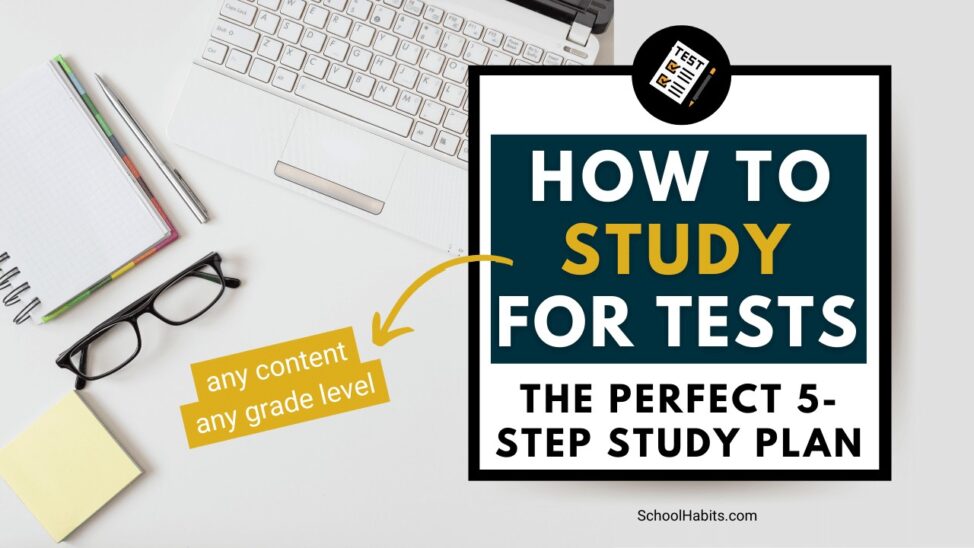
By Katie Azevedo, M.Ed.
My website analytics show me that how to study for tests is the second most searched term on my website. (First place is how to take notes.) I have written over 100 tutorials about study skills for this very reason. With that said, this blog post is a step back from the nitty-gritty study hacks I often write about: In this post, I’m sharing 5 strategic steps that every legitimate study session must be built upon.
How to study for tests: The perfect 5-step study plan
Remember, the following strategies are the foundation for studying for any test – on any content, at any grade level. The steps are a combination of time management, strategic planning, common sense, cognitive science, and nitty-gritty study hacks. (How long should you be studying each day? Here’s what I recommend.)
Note: When you get to step 5, feel free to use any number of the detailed and specific study strategies I’ve written about here and here. Whatever you do, don’t use these.
1. Know when to begin.
I argue that the optimal amount of time to study for most tests is two weeks. Looking at your syllabus or taking cues from your teacher, count backward about two weeks out from your test date and start studying on this day. Look at a calendar and figure out exactly what time each day you will spend studying: aim for 45-90 minute chunks for each study session.
If you are not given two weeks’ notice, then begin studying as soon as you learn about the test. Follow my ultimate 5-day study plan if you have 5 days’ notice. The reason you must begin studying in advance is that doing so is the only way to use the study strategy of spaced repetition, which is one of the top two study methods ever.
Hey – guess what?! I have a free Study Planner Template that can help you plan out and organize your next study session. You can print it or download it to use digitally.
2. Know what’s on the test.
You don’t have time or brain energy to study anything beyond exactly what’s on the test. Ask your teacher or check your syllabus for this information.
3. Gather and consolidate your materials.
After you figure out what the test is on, gather all of the materials you have on the topic. You may have to go to several sources to collect this information, such as paper handouts, your notebook, teacher slide decks, online videos, cheat sheets if you’ve made them, textbooks, etc. This step takes some time, but you can’t move to step 4 without following this step perfectly. You may spend an entire 45-90 minute study session just gathering your materials, and that’s okay.
Next, after you’ve gathered your materials, organize and consolidate them. For example, print out online resources and combine them with your paper notes, clip together materials on the same subject, get rid of duplicates, etc. At the end of this step, you should have one to two “packets” of material (analog, digital, or both) that you will use in the next step.
4. Make a study guide.
Here are the exact steps for making a study guide. You can vary up the aesthetic and some of the details, but stick to the general structure as much as you can. Just like the previous step, this step will likely consume one or two full 45-90 minute study sessions. Don’t rush this step. You might be eager to get to the final step in this whole process, but making your study guide is one of the most important parts of studying.
5. Study by using active recall to test yourself.
You’ve finally arrived at the last step in this How to Study for Tests guide. Many students bypass steps 1-4 to get here, but I hope I’ve made it clear that you should do no such thing. If you’ve taken the time to plan your study calendar, figure out what’s on the test, gather and consolidate your materials, and make your study guide, then this final step should fall into place.
There is hands-down no better study strategy than active recall. Here is exactly how to use active recall, but the gist is that you must, MUST put yourself in the uncomfortable position of testing yourself on the material without looking at your notes. This process can get sticky, awkward, and irritating – but do it anyway.
How to study for tests – final notes
Knowing how to study for tests using the exact method I’ve outlined in this post will prepare you for any test in any subject matter. If the test requires that you actually KNOW the material (and not simply memorize it for 30 minutes), then … wait for it … there are no shortcuts. Sorry! If there were, you better believe I’d share them with you. If you’re a college student, your next step is to check out my 12 study tips just for college students. You can find those study tips right here.

